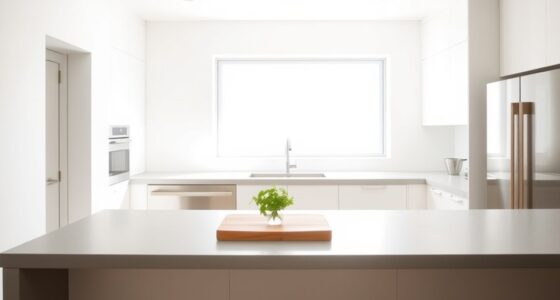To apply minimalism in your life, use negative space intentionally by creating moments of silence and simplicity. Focus on eliminating clutter and unnecessary commitments so that only what truly matters stands out. Balance your priorities and surround yourself with thoughtful, purposefully chosen elements, including colors that evoke calm or highlight what’s important. Embracing these principles can bring clarity, purpose, and peace—if you continue exploring, you’ll discover how to craft a more balanced, intentional existence.
Key Takeaways
- Use negative space in daily life to create mental clarity and reduce overwhelm.
- Simplify environments by removing clutter, highlighting what truly matters.
- Prioritize with intentional balance, focusing on essential commitments and values.
- Emphasize meaningful moments and choices, akin to bold focal points in art.
- Cultivate calm and reflection through minimalism, fostering purpose and serenity.

Have you ever wondered how simplicity can make a powerful statement in art? When you embrace minimalism, you focus on stripping away the unnecessary, leaving only what truly matters. This approach emphasizes visual balance, where each element on the canvas or in a space plays a crucial role. In minimalist art, the careful placement of objects creates harmony, guiding your eye effortlessly and evoking calm and clarity. It’s not about filling every inch but about intentionally choosing what to include, letting negative space do its job. This negative space is just as important as the objects themselves, providing breathing room and highlighting the main features. It helps you see the subject more clearly and makes the overall composition feel intentional and balanced.
Color saturation also plays a critical role in minimalist art. Since there are fewer elements, each color choice has a bigger impact. You might find that artists use muted tones to evoke serenity or bold, saturated colors to make a striking statement. The key is that the colors aren’t overwhelming; instead, they’re carefully chosen to complement the overall design. When you use high saturation sparingly, it draws attention and creates a focal point, making your message more direct. Conversely, subdued tones can foster a feeling of tranquility and openness, encouraging viewers to pause and reflect. The contrast in color saturation helps emphasize the importance of each element while maintaining the simplicity that’s core to minimalism.
Using sparing, carefully chosen colors enhances simplicity and draws focus in minimalist art.
Applying these principles to your own life can be transformative. Think of negative space as the moments of silence or stillness that give your thoughts and routines room to breathe. When you declutter your environment or mind, you’re creating space that allows the essentials to shine. Just like in art, achieving visual balance in your daily life involves intentionally arranging your priorities and commitments. Use color—metaphorically or literally—to highlight what truly matters, whether it’s through your choices, your environment, or your focus. Embracing minimalism isn’t about deprivation; it’s about clarity and purpose. By reducing unnecessary distractions, you can find a more peaceful and meaningful existence.
Understanding the importance of local laws can help you make more informed decisions when simplifying your life or environment. In essence, minimalism teaches you that less is often more. With a deliberate eye for visual balance and thoughtful use of color saturation, you can craft a life—and art—that’s powerful in its simplicity. It’s about making space for what truly matters and allowing the beauty of negative space to enhance your perspective. When you master these elements, you’ll discover that true elegance comes not from excess, but from the thoughtful restraint that elevates every detail.
Frequently Asked Questions
How Does Negative Space Influence Emotional Perception in Art?
Negative space influences your emotional perception by creating a sense of calm, focus, and openness. It enhances emotional resonance, allowing you to feel more connected or introspective about the artwork. By guiding your attention and shaping viewer psychology, negative space can evoke feelings of tranquility or intensity, depending on its use. This strategic emptiness helps you experience the artwork more deeply and personally, making its emotional impact more powerful.
Can Minimalism Be Applied to Digital and Virtual Environments?
Yes, you can definitely apply minimalism to digital and virtual environments. Embracing digital simplicity involves stripping away unnecessary elements, making interfaces cleaner and more intuitive. Virtual minimalism focuses on reducing clutter and distractions, helping users focus on essential content. By intentionally using negative space and simple design principles, you create calming, efficient digital spaces that improve user experience and foster a sense of clarity.
What Are Common Mistakes When Incorporating Negative Space?
When incorporating negative space, you often mistake clutter for balance or overlook how excess distraction can disrupt harmony. Avoid filling every gap; instead, give your design room to breathe. Too much negative space can feel empty, while too little creates chaos. Aim for a mindful balance where negative space complements your focal points, enhancing clarity without overwhelming. Remember, harmony is achieved through thoughtful restraint, not excess.
How Does Minimalism Impact Viewer Engagement and Interpretation?
Minimalism makes your mind more mindful by magnifying visual focus and sparking viewer curiosity. When you embrace simplicity, you allow key elements to stand out, drawing attention and inviting interpretation. This clean, uncluttered approach encourages viewers to engage more deeply, contemplate meaning, and connect emotionally. By reducing distractions, minimalism transforms passive viewing into an active experience, fostering a powerful, personal perception of art and life.
Are There Cultural Differences in the Use of Negative Space?
Yes, there are cultural differences in the use of negative space. You’ll notice that in some cultures, like Japanese or Chinese art, negative space embodies cultural symbolism, representing harmony or spirituality. Meanwhile, Western aesthetic preferences often emphasize clean, uncluttered designs to evoke simplicity. By understanding these cultural nuances, you can better appreciate how negative space communicates deeper meanings across diverse artistic traditions.
Conclusion
By embracing minimalism in your life, you free yourself from clutter and distraction, allowing clarity to flourish. Think of it like this: studies show that a cluttered space can increase stress by up to 60%. When you apply negative space thoughtfully, you create room for what truly matters. So, take a step back, simplify, and let the empty spaces breathe—you might just find more peace and purpose in what remains.








